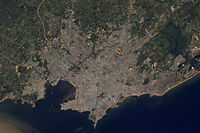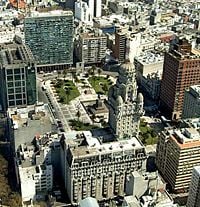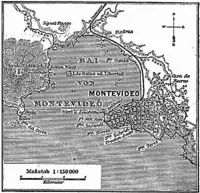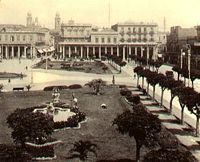Difference between revisions of "Montevideo" - New World Encyclopedia
| Line 5: | Line 5: | ||
| official_name = Montevideo | | official_name = Montevideo | ||
| image_skyline = Montevideo Panorama.jpg| | | image_skyline = Montevideo Panorama.jpg| | ||
| − | | image_caption = Montevideo from the [[Telecommunications Tower]] | + | | image_caption = Montevideo from the [[Telecommunications Tower]]|subdivision_type= Country |subdivision_name=[[Uruguay]] |subdivision_type1 = [[Departments of Uruguay|Department]] |
| − | |subdivision_type= Country |subdivision_name=[[Uruguay]] |subdivision_type1 = [[Departments of Uruguay|Department]] | ||
| subdivision_name1 = Montevideo Department | | subdivision_name1 = Montevideo Department | ||
| elevation_m = 43 | | elevation_m = 43 | ||
| Line 13: | Line 12: | ||
|established_title= Founded | |established_title= Founded | ||
| established_date = 1726 | | established_date = 1726 | ||
| − | | founder = Bruno Mauricio de Zabala | + | | founder = Bruno Mauricio de Zabala| population_total = 1,325,968 |
| − | | population_total = 1,325,968 | ||
| Time Zone = GMT -3|utc_offset=-3 |timezone_DST =GMT -2 ([[DST]])|utc_offset_DST =-2 | | Time Zone = GMT -3|utc_offset=-3 |timezone_DST =GMT -2 ([[DST]])|utc_offset_DST =-2 | ||
| population_as_of = 2004 | | population_as_of = 2004 | ||
| Line 26: | Line 24: | ||
}} | }} | ||
| − | '''Montevideo''' ({{IPA2|monteβi'deo}}) is the largest city, capital and chief port of [[Uruguay]]. Montevideo is | + | '''Montevideo''' ({{IPA2|monteβi'deo}}) is the largest city, capital and chief port of [[Uruguay]]. Montevideo is the only city in the country with a population over 1 million. It has a privileged harbor, one of the most important in the [[Americas]], and beautiful beaches. According to the Mercer Human Resource Consulting, Montevideo is the [[Latin America]]n city with the highest quality of life (followed by [[Buenos Aires]] and [[Santiago de Chile]])<ref>[http://www.answers.com/topic/ranking-of-latin-american-cities Ranking of Latin American cities, Quality of life section]. See also [http://www.lanacion.cl/prontus_noticias/site/artic/20070401/pags/20070401204943.html ''La Nación''] -Chilean newspaper article that mentions the three Latin American cities with highest quality of life according to the MHRC 2007 investigation (Spanish)</ref>. It is among the 30 safest cities in the world <ref>[http://www.propertyinuruguay.com/open-realty236%5B1%5D/index.php Property in Uruguay]</ref> and the second safest capital city. <ref>[http://www.studyabroadinternational.com/Uruguay/Atlantida/Uruguay_Atlantida.html Montevideo, the second safest capital city in the world] at [http://www.studyabroadinternational.com StudyAbroadInternational.com]</ref>. |
==Population== | ==Population== | ||
| − | + | As of 2004, the city has a population of 1.35 million out of a total of 3.43 million in the country as a whole.[http://aol.countrywatch.com/aol_country.asp?vcountry=183] The greater [[metropolitan area]] has 1.8 million people | |
| − | |||
Montivideans have very strong European origins, with Italian and Spanish descent being the most common. There are also important African descent and Jewish communities. | Montivideans have very strong European origins, with Italian and Spanish descent being the most common. There are also important African descent and Jewish communities. | ||
| − | Montevideo's population makes up roughly 44 | + | Montevideo's population makes up roughly 44 percent of the entire country of Uruguay. The surrounding province of [[Canelones]], essentially Montevideo's suburbs and direct rural area, makes up another 12 percent. |
==Geography== | ==Geography== | ||
| − | Montevideo | + | Montevideo lies at the midpoint of Uruguay's coast, where an estuary called the [[Rio de la Plata]] meets the Atlantic Ocean. The geographic coordinates are 34.5° S, 56°W. |
| − | + | The Avenida 18 de Julio is the city's main artery and extends from the [[Plaza Independencia]], through the main business district. The park is surrounded by historic buildings that include the Government House, the Museum of Natural History, the Salvo Palace, the Solis Theater, and the Victoria Plaza Hotel. The tomb of Uruguay's leader of independence from Spain, [[Jose Gervasio Artigas]], lies at the center of the park. The avenue gets its name from July 18, 1830, the date Uruguay adopted its first constitution. West of the plaza, an arch leads to a historic district called ''[[Ciudad Vieja, Montevideo|Ciudad Vieja]]'' or Old Town. This district has many buildings that date from the 1700s or 1800s. | |
{{sectstub}} | {{sectstub}} | ||
| Line 56: | Line 53: | ||
===Early History=== | ===Early History=== | ||
| − | + | The first European to explore Uruguay was the Spanish navigator [[Juan Díaz de Solís]]in 1516. He and his group were killed by [[Charrúa]] or [[Guaraní]] Indians. | |
| − | + | ||
| + | The Portuguese explorer [[Ferdinand Magellan]] anchored at the future site of Montevideo in 1520, and the British navigator [[Sebastian Cabot]] led a Spanish expedition up the [[Río de la Plata]] in 1526. The area attracted little interest for settlement owing to a lack of mineral wealth and the hostility of the Indians. | ||
| + | |||
| + | This changed however, when in 1680 the [[Portugal|Portuguese]] founded [[Colonia del Sacramento]], across the Rio de la Plata from [[Buenos Aires]], despite Spanish claims to the area based on the [[Treaty of Tordesillas]]. | ||
| − | + | The [[Spain|Spanish]] chased the Portuguese out of a fort in the area in 1724. Then, [[Bruno Mauricio de Zabala]] – [[governor]] of Buenos Aires – founded the city of Montevideo on December 24, 1726 to prevent further incursions. | |
| − | The city fell under heavy [[United Kingdom|British]] influence from the early [[ | + | From 1807 to 1830 Montevideo was alternately occupied by British, Spanish, Argentine, Portuguese, and Brazilian forces, and its trade and population declined. In 1828, the town became the capital of Uruguay. However independence, which came in 1830, did not bring stability. Rivalries between local inhabitants, Argentines, and Brazilians led to a nine-year siege of Montevideo by a combined Argentine-Uruguayan army from 1843 to 1851. French and English forces assisted Montevideo's defenders by blockading Buenos Aires. The unexpected result was that Montevideo flourished during the siege and became the major port of the Río de la Plata. |
| + | |||
| + | The city fell under heavy [[United Kingdom|British]] influence from the early [[nineteenth century]] until the early [[twentieth century]] as a way to circumvent [[Argentine]] and [[Brazilian]] commercial control. It was repeatedly besieged by Argentinean dictator [[Juan Manuel de Rosas]] between 1838 and 1851. Between 1860 and 1911, British-owned railway companies built an extensive [[railroad]] network linking the city to the surrounding countryside. | ||
===20th Century=== | ===20th Century=== | ||
| Line 67: | Line 69: | ||
[[Image:MontevideoIndependencePlaza1900.jpg|thumb|left|200px|Independence Plaza, c. 1900]] | [[Image:MontevideoIndependencePlaza1900.jpg|thumb|left|200px|Independence Plaza, c. 1900]] | ||
| − | During | + | During the early 1900s, Uruguay became one of the most prosperous and democratic nations in South America. |
| + | |||
| + | Jose Batlle y Ordoñez, president from 1903 to 1907 and again from 1911 to 1915, initiated widespread political, social, and economic reforms that established a statist tradition. Some of these reforms were continued by his successors. | ||
| + | |||
| + | But an economic decline during the 1950s and 1960s brought about a period of widespread unrest. In the late 1960s a violent Marxist urban guerrilla movement called the [[Tupamaros]], carried out kidnappings and murders of Uruguayan and foreign officials. This led Uruguay's president to cede control of the government to the military in 1973. By year's end, the rebels had been crushed, but the military continued to expand its hold over the government. Civilian rule was not restored until 1985. | ||
| + | |||
| + | In 2004, the left-of-center [[Frente Amplio]] (Broad Front Coalition) won national elections that effectively ended 170 years of political control previously held by the [[Partido Colorado]] and [Partido Blanco]] parties. Uruguay's political and labor conditions are among the freest on the continent. | ||
| − | Since 2005 the [[Mayor]] of Montevideo (styled ''Intendente Municipal'' in Spanish) has been [[Ricardo Ehrlich]], of the [[Frente Amplio]] | + | Since 2005 the [[Mayor]] of Montevideo (styled ''Intendente Municipal'' in Spanish) has been [[Ricardo Ehrlich]], of the [[Frente Amplio]], gaining 61 percent of the vote and beating [[Pedro Bordaberry]] of the center-right [[Partido Colorado]], who scored 27 percent. |
==Growth/economy== | ==Growth/economy== | ||
| − | + | The [[military dictatorship]] of the 1970s, and [[economic stagnation]] caused a decline whose residual effects are still seen today. Many rural poor flooded the city, with a large concentration in Ciudad Vieja. | |
| − | + | In 2002, Uruguay went through the steepest economic and financial crisis in recent history, which developed mostly from external factors. Uruguay’s economy rebounded in 2003--with a 2.5 percent rise in GDP—and surged in 2004 and 2005 with growth rates of 12.3 percent and 6.6 percent, respectively. Growth equaled 7.0 percent in 2006 and is expected to reach 4.5 percent in 2007. | |
| − | + | The Uruguayan government employs more than one-third of the workers of Montevideo. The city's important industries include textile manufacturing, banking, and tourism. Wines and dairy products also are produced. | |
| − | + | Most of Uruguay's exports and imports pass through Montevideo's port. Among the main exports are wool, meat, and hides. | |
| − | + | The port is also served by the [[Carrasco International Airport]]. Four railroads converge on the city, and roads lead to other principal cities. | |
{{Panorama2|Montevideo Panorama.jpg|1450px|Panorama of Montevideo. Taken from the Torre Antel Torre de las Telecomunicaciones. The [Palacio Salvo is visible on the far right}} | {{Panorama2|Montevideo Panorama.jpg|1450px|Panorama of Montevideo. Taken from the Torre Antel Torre de las Telecomunicaciones. The [Palacio Salvo is visible on the far right}} | ||
| Line 172: | Line 180: | ||
==Education== | ==Education== | ||
| + | The city has an excellent system of public education and is the home of the University of the Republic and the Technical University of Uruguay. Higher education in Uruguay is available only in the capital. | ||
| − | + | ==Culture== | |
| − | + | Montevideo's first theater was the Casa de Comedias, which opened in 1795. This was followed by the Teatro San Felipe. The Teatro Solís, still in existence, was opened in 1856. The city also houses the Museo Histórico Nacional (National History Museum, 1900), the Museo Nacional de Historia Natural (Museum of Natural History, 1837), the Museo Nacional de Bellas Artes (Museum of Fine Arts, 1911), and the Biblioteca Nacional del Uruguay (National Library, 1816). | |
| − | |||
| − | |||
| − | |||
| − | |||
| − | |||
| − | |||
| − | |||
| − | |||
| − | |||
| − | |||
| − | |||
| − | == | ||
| − | |||
| − | Montevideo | ||
| − | |||
| − | + | ==Sports and Recreation== | |
| + | Soccer is the most popular sport in Montevideo and Uruguay. Its stadium [[Estadio Centenario]] is considered among the most famous in the region, and has hosted the [[1930 FIFA World Cup|1<sup>st</sup> FIFA World Cup]]. Other popular sports include basketball and rugby. [[Gaucho]] rodeos, called domos, attract many spectators. The city's fine beaches draw | ||
| + | large crowds in the summer. | ||
==Sites of interest== | ==Sites of interest== | ||
Revision as of 19:55, 18 September 2007
Ray Mas
- For other uses, see Montevideo (disambiguation).
| Montevideo | |
| Montevideo from the Telecommunications Tower | |
| Coordinates: 34°53′S 56°10′W | |
|---|---|
| Country | Uruguay |
| Department | Montevideo Department |
| Founded | 1726 |
| Founder | Bruno Mauricio de Zabala |
| Elevation | 43 m (141 ft) |
| Population (2004) | |
| - Total | 1,325,968 |
| - Rank | 1st |
| - Demonym | Montevideano |
| postal code | 10000 |
| Area code(s) | +02 |
Montevideo (IPA: [monteβi'deo]) is the largest city, capital and chief port of Uruguay. Montevideo is the only city in the country with a population over 1 million. It has a privileged harbor, one of the most important in the Americas, and beautiful beaches. According to the Mercer Human Resource Consulting, Montevideo is the Latin American city with the highest quality of life (followed by Buenos Aires and Santiago de Chile)[1]. It is among the 30 safest cities in the world [2] and the second safest capital city. [3].
Population
As of 2004, the city has a population of 1.35 million out of a total of 3.43 million in the country as a whole.[1] The greater metropolitan area has 1.8 million people
Montivideans have very strong European origins, with Italian and Spanish descent being the most common. There are also important African descent and Jewish communities.
Montevideo's population makes up roughly 44 percent of the entire country of Uruguay. The surrounding province of Canelones, essentially Montevideo's suburbs and direct rural area, makes up another 12 percent.
Geography
Montevideo lies at the midpoint of Uruguay's coast, where an estuary called the Rio de la Plata meets the Atlantic Ocean. The geographic coordinates are 34.5° S, 56°W.
The Avenida 18 de Julio is the city's main artery and extends from the Plaza Independencia, through the main business district. The park is surrounded by historic buildings that include the Government House, the Museum of Natural History, the Salvo Palace, the Solis Theater, and the Victoria Plaza Hotel. The tomb of Uruguay's leader of independence from Spain, Jose Gervasio Artigas, lies at the center of the park. The avenue gets its name from July 18, 1830, the date Uruguay adopted its first constitution. West of the plaza, an arch leads to a historic district called Ciudad Vieja or Old Town. This district has many buildings that date from the 1700s or 1800s.
History
Origin of Name
There are at least two explanations for the name Montevideo: The first states that it comes from the Portuguese "Monte vide eu" which means "I see a mountain." The second is that the Spaniards recorded the location of a mountain in a map as "Monte VI De Este a Oeste" meaning "The sixth mountain from east to west." The city's full original name is San Felipe y Santiago de Montevideo.
Early History
The first European to explore Uruguay was the Spanish navigator Juan Díaz de Solísin 1516. He and his group were killed by Charrúa or Guaraní Indians.
The Portuguese explorer Ferdinand Magellan anchored at the future site of Montevideo in 1520, and the British navigator Sebastian Cabot led a Spanish expedition up the Río de la Plata in 1526. The area attracted little interest for settlement owing to a lack of mineral wealth and the hostility of the Indians.
This changed however, when in 1680 the Portuguese founded Colonia del Sacramento, across the Rio de la Plata from Buenos Aires, despite Spanish claims to the area based on the Treaty of Tordesillas.
The Spanish chased the Portuguese out of a fort in the area in 1724. Then, Bruno Mauricio de Zabala – governor of Buenos Aires – founded the city of Montevideo on December 24, 1726 to prevent further incursions.
From 1807 to 1830 Montevideo was alternately occupied by British, Spanish, Argentine, Portuguese, and Brazilian forces, and its trade and population declined. In 1828, the town became the capital of Uruguay. However independence, which came in 1830, did not bring stability. Rivalries between local inhabitants, Argentines, and Brazilians led to a nine-year siege of Montevideo by a combined Argentine-Uruguayan army from 1843 to 1851. French and English forces assisted Montevideo's defenders by blockading Buenos Aires. The unexpected result was that Montevideo flourished during the siege and became the major port of the Río de la Plata.
The city fell under heavy British influence from the early nineteenth century until the early twentieth century as a way to circumvent Argentine and Brazilian commercial control. It was repeatedly besieged by Argentinean dictator Juan Manuel de Rosas between 1838 and 1851. Between 1860 and 1911, British-owned railway companies built an extensive railroad network linking the city to the surrounding countryside.
20th Century
During the early 1900s, Uruguay became one of the most prosperous and democratic nations in South America.
Jose Batlle y Ordoñez, president from 1903 to 1907 and again from 1911 to 1915, initiated widespread political, social, and economic reforms that established a statist tradition. Some of these reforms were continued by his successors.
But an economic decline during the 1950s and 1960s brought about a period of widespread unrest. In the late 1960s a violent Marxist urban guerrilla movement called the Tupamaros, carried out kidnappings and murders of Uruguayan and foreign officials. This led Uruguay's president to cede control of the government to the military in 1973. By year's end, the rebels had been crushed, but the military continued to expand its hold over the government. Civilian rule was not restored until 1985.
In 2004, the left-of-center Frente Amplio (Broad Front Coalition) won national elections that effectively ended 170 years of political control previously held by the Partido Colorado and [Partido Blanco]] parties. Uruguay's political and labor conditions are among the freest on the continent.
Since 2005 the Mayor of Montevideo (styled Intendente Municipal in Spanish) has been Ricardo Ehrlich, of the Frente Amplio, gaining 61 percent of the vote and beating Pedro Bordaberry of the center-right Partido Colorado, who scored 27 percent.
Growth/economy
The military dictatorship of the 1970s, and economic stagnation caused a decline whose residual effects are still seen today. Many rural poor flooded the city, with a large concentration in Ciudad Vieja.
In 2002, Uruguay went through the steepest economic and financial crisis in recent history, which developed mostly from external factors. Uruguay’s economy rebounded in 2003—with a 2.5 percent rise in GDP—and surged in 2004 and 2005 with growth rates of 12.3 percent and 6.6 percent, respectively. Growth equaled 7.0 percent in 2006 and is expected to reach 4.5 percent in 2007.
The Uruguayan government employs more than one-third of the workers of Montevideo. The city's important industries include textile manufacturing, banking, and tourism. Wines and dairy products also are produced.
Most of Uruguay's exports and imports pass through Montevideo's port. Among the main exports are wool, meat, and hides.
The port is also served by the Carrasco International Airport. Four railroads converge on the city, and roads lead to other principal cities.
Template:Panorama2
World City Formation
The city shows "some evidence" of world city formation.
Neighbourhoods
|
|
|
Education
The city has an excellent system of public education and is the home of the University of the Republic and the Technical University of Uruguay. Higher education in Uruguay is available only in the capital.
Culture
Montevideo's first theater was the Casa de Comedias, which opened in 1795. This was followed by the Teatro San Felipe. The Teatro Solís, still in existence, was opened in 1856. The city also houses the Museo Histórico Nacional (National History Museum, 1900), the Museo Nacional de Historia Natural (Museum of Natural History, 1837), the Museo Nacional de Bellas Artes (Museum of Fine Arts, 1911), and the Biblioteca Nacional del Uruguay (National Library, 1816).
Sports and Recreation
Soccer is the most popular sport in Montevideo and Uruguay. Its stadium Estadio Centenario is considered among the most famous in the region, and has hosted the 1st FIFA World Cup. Other popular sports include basketball and rugby. Gaucho rodeos, called domos, attract many spectators. The city's fine beaches draw large crowds in the summer.
Sites of interest
- Estadio Centenario
- Palacio Salvo
- Torre de las Telecomunicaciones
- Teatro Solís
- Palacio Legislativo
- Catedral Metropolitana
- Cabildo de Montevideo
- Mercado del Puerto
- Playa Pocitos
- Parque Rodo
- Palacio Pitamiglio
Sister cities
 Québec City, Canada
Québec City, Canada Barcelona, Spain
Barcelona, Spain Montevideo, USA
Montevideo, USA Miami, USA
Miami, USA Curitiba, Brazil
Curitiba, Brazil Qingdao, PRC
Qingdao, PRC Saint Petersburg, Russia
Saint Petersburg, Russia
ReferencesISBN links support NWE through referral fees
- ↑ Ranking of Latin American cities, Quality of life section. See also La Nación -Chilean newspaper article that mentions the three Latin American cities with highest quality of life according to the MHRC 2007 investigation (Spanish)
- ↑ Property in Uruguay
- ↑ Montevideo, the second safest capital city in the world at StudyAbroadInternational.com
External links
- Montevideo official website
- (Spanish) PRESS The First Uruguayan Neighborhood and Documentatio Agency
- (Spanish)/(English) A City Built by Us All
- Many nice pictures of Montevideo
- Panoramic pictures of Montevideo
- Montevideo Hotels
- A Maverick's Odyssey - Photo blog of life in Montevideo, Uruguay.
- Uruguay Dreaming - Blog about life and customs in Montevideo and Uruguay.
-
- Mapping from Multimap or GlobalGuide or Google Maps
- Satellite image from WikiMapia
- Mapping from OpenStreetMap
- Montevideo Pop Music: Site of the band with the name of the city
| Departments of Uruguay | |
|---|---|
| Artigas | Canelones | Cerro Largo | Colonia | Durazno | Flores | Florida | Lavalleja | Maldonado | Montevideo | Paysandú | Río Negro | Rivera | Rocha | Salto | San José | Soriano | Tacuarembó | Treinta y Tres |
Asunción, Paraguay · Bogotá, Colombia · Brasília, Brasil · Buenos Aires, Argentina · Caracas, Venezuela · Cayenne, French Guiana · Georgetown, Guyana · Grytviken, South Georgia and the South Sandwich Islands · La Paz, Bolivia · Lima, Peru · Montevideo, Uruguay · Paramaribo, Suriname · Quito, Ecuador · Santiago, Chile · Sucre, Bolivia · Stanley, Falkland Islands
Credits
New World Encyclopedia writers and editors rewrote and completed the Wikipedia article in accordance with New World Encyclopedia standards. This article abides by terms of the Creative Commons CC-by-sa 3.0 License (CC-by-sa), which may be used and disseminated with proper attribution. Credit is due under the terms of this license that can reference both the New World Encyclopedia contributors and the selfless volunteer contributors of the Wikimedia Foundation. To cite this article click here for a list of acceptable citing formats.The history of earlier contributions by wikipedians is accessible to researchers here:
The history of this article since it was imported to New World Encyclopedia:
Note: Some restrictions may apply to use of individual images which are separately licensed.




